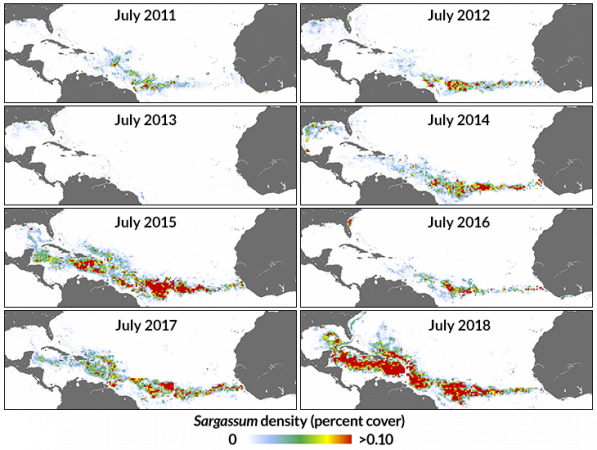Record seaweed belt spanned from Africa to Gulf of Mexico
The enormous Sargassum bloom seen in 2018 could become the new normal, scientists worry

Vast mats of Sargassum seaweed can be seen floating off of Florida’s Big Pine Key. These can shelter everything from turtles to eels to fish. But an overgrowth of these mats has begun posing a problem for coastlines.
Brian Lapointe/Florida Atlantic University's Harbor Branch Oceanographic Institute
Share this:
- Share via email (Opens in new window) Email
- Click to share on Facebook (Opens in new window) Facebook
- Click to share on X (Opens in new window) X
- Click to share on Pinterest (Opens in new window) Pinterest
- Click to share on Reddit (Opens in new window) Reddit
- Share to Google Classroom (Opens in new window) Google Classroom
- Click to print (Opens in new window) Print
In summer, vast floating islands of algae can cover parts of the tropical Atlantic Ocean. Known as Sargassum, this algae reached record levels last year. The giant brown belt it formed in June 2018 extended from the west coast of Africa into the Gulf of Mexico — a span of 8,850 kilometers (5,500 miles)! The largest bloom of seaweed ever detected, it weighed at least 20 million metric tons, a new report finds. For perspective, that is about four times the weight of the Great Pyramid of Giza in Egypt.
Mengqiu Wang is an optical oceanographer at the University of South Florida in Tampa. She uses imagery to study the seas. Wang and her colleagues tracked the Sargassum mats over the last 19 years using satellite data. These revealed those mats suddenly expanded dramatically in the summer of 2011. And those massive blooms recurred almost every year since then.
Atlantic’s July Sargassum algae bands, 2011 to 2018

Researchers have dubbed these massive mats of seaweed the great Atlantic Sargassum belt. These floating algae islands have long provided an important shelter for turtles, fish, crabs, eels and other marine species. But there can be too much of a good thing. When they crowd coastlines, these mats can smother corals and seagrass. They also can litter and wreak coastal beaches along the Caribbean and Gulf of Mexico with layers of heavy, rotting seaweed that is meters (yards) thick.
The yearly Sargassum bloom has been fueled partly by nutrients pouring into the ocean from the Amazon River, the new study suggests. Forests can both regulate the flow of water from land to ocean and filter out some of the materials in it. But farms around the Amazon River are expected to increase their use of fertilizers (nutrients) in the decades ahead. People along the river’s tributaries also have been cutting down huge swaths of forests. That, too, is expected to continue. Such trends could mean that colossal Sargassum blooms may become the new normal, Wang’s team says in the July 5 Science.
Eyed from the sky
The researchers analyzed data from satellite instruments that scan the ocean in visible and infrared light. Like photosynthetic plants, Sargassum algae contain lots of green. It comes from a pigment known as chlorophyll-a. This pigment shows up brightly at infrared wavelengths. That makes it contrast sharply with the darker water below.
In the 10 years leading up to 2010, there was little of the algae in the central Atlantic Ocean. An occasional patch would emerge near the mouth of the Amazon River in the summer and fall. But things changed in 2011. A band of seaweed suddenly developed all the way across the ocean.
This change in 2011 “was really surprising,” says James Gower. Also an optical oceanographer, he works at Fisheries and Oceans Canada in North Saanich, British Columbia. “It really stood out in the satellite data,” he noted. He coauthored a commentary on the finding in the same issue of Science.
Each year since — except for 2013 — the algae have formed a similar, vast belt. Last year’s was the largest and densest yet, Wang’s team notes.
Two sources of nutrients appear to be feeding the blooms. One is the release of nutrients from the Amazon River. The other is an upwelling of water along the coast of West Africa. This is where strong winds push aside surface waters for long periods. This allows deeper, nutrient-rich waters to rise toward the surface. Such upwellings occur off Africa naturally, due to interaction caused by winds, the ocean and Earth’s rotation.
How those nutrients might change in the future is unclear. There’s much that scientists still don’t know about the sources of those nutrients. They’ve also much to learn about how climate change will affect the seaweed’s life cycle. Nutrients carried on dust may have a role. They get blown into the ocean from the Sahara Desert as well as from places along Africa’s Congo River.
For instance, the team notes, particularly warm temperatures at the sea surface appear to suppress the algae’s growth. That’s what happened in 2013. That could cast some doubt on the size the blooms to be expected in a warming world, the researchers note.
Being able to eye seaweed from the sky has been key to witnessing its widescale patterns in growth. Even higher-resolution satellite data of the world’s oceans could help researchers better track the movement of such algae, Gower says. And that might help figure out what’s really causing the blooms.







